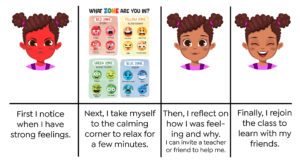Fostering positive behavior and self-regulation is a collaborative journey between educators and students. Like other areas in education, classroom management and behavioral modification need to be differentiated. Social stories are an effective empathetic tool for shifting behaviors and enhancing self-regulation within and beyond the classroom.
Understanding Social Stories: A Compassionate Approach to Behavioral Modification
Social stories, a concept introduced by Carol Gray in the early 1990s, are short narratives that describe social situations, skills, or concepts in a clear and structured manner (Gray, 2015). These stories are specifically designed to help individuals, especially those with autism spectrum disorders, comprehend and navigate the complexities of social interactions. However, many students can benefit from these tools and the impact extends far beyond the classroom setting.

Creating Effective Social Stories: A Step-by-Step Guide
1. Identify the Target Behavior or Skill
Begin by pinpointing the specific behavior or skill you wish to address. Whether it’s sharing, taking turns, or managing frustration, clarity for the student and the teacher is key. Remember that we are focusing on what we need to happen, not on behaviors we need to remove from the classroom experience.
2. Tailor the Story to the Individual
Stories will often apply to multiple students, but it is important to personalize each stroy to the unique experiences, needs, and challenges of the child. The teacher will guide the process, but when the story is co-constructed, the language and images will be familiar and the child will have a sense of ownership of “their story”. The child has a say in this process from the beginning until decisions are being made about retiring stories that are no longer needed.
3. Use clear and Positive Language
Craft narrative with the child using clear, positive, and age appropriate language. Focus on describing the desired behavior or skill in a constructive manner and never in a way that feels like a judgement or punishment.
4. Incorporate Visual Supports
Enhance comprehension by including visual supports such as images or icons that illustrate key points. Visuals provide additional clarity, aid in memory retention, and can be easier to process when students are in crisis. Illustrations replace text entirely for students who are not yet independent readers.
5. Outline the Situation and Expected Responses
Clearly outline the social situation, breaking it down into sequential steps. Describe the expected responses or actions lead to positive consequences and potential rewards including being able to interact and learn within the classroom setting.
6. Highlight Consequences and Rewards
Emphasize the positive outcomes associated with exhibiting the desired behavior. Reinforce the idea that positive actions lead to positive consequences and potential rewards including being able to interact and learn within the classroom setting.
7. Read and Discuss
Introduce the social story through interactive reading. Engage the student in discussions about the story, encouraging questions and reflections.
8. Reinforce and Review
Consistency is key. Regularly revisit the social story, reinforcing its messages during appropriate moments. This repetition aids in internalizing and transferring the desired behavior.
9. Revise or Retire
Like any scaffold, social stories are meant to be a temporary support. As you review a child’s story and progress together, either you or the child can make suggestions for changing images or language, removing or adding sections, or even retiring the story and moving on to the next goal.
The Transformative Impact on Classroom Dynamics
The goal of social stories goes beyond simply modifying behavior. The approach outlined is culturally responsive and honors the learner as a whole person who, with support, can develop the efficacy and agency to thrive in and out of school.
1. Empowering Students with Understanding
Social stories empower students by providing a roadmap for understanding and navigating social situations. This heightened awareness contributes to a sense of control and self-regulation and levels the playing field for students who do not yet know the many “unwritten rules” of positive, acceptable social interactions and behaviors.
2. Encouraging Empathy and Perspective-Taking
Through social stories, students gain insights into the feelings and experiences of others. This promotes empathy and perspective-taking, fostering a classroom culture of understanding and cooperation.
3. Building a Positive Behavior Culture
The positive and constructive language embedded in social stories helps shape a culture of positive behavior within the classroom. Students internalize the desired behaviors, creating a supportive learning environment.
4. Personalized Support for Diverse Learners
Social stories can be tailored to address the specific needs of individual students. This personalized approach ensures that each learner receives the differentiated, targeted support necessary to meet their unique challenges.
5. Agency for All Learners
Students may feel powerless, or even hopeless, while they are developing self-regulation. This is especially true when they continually break rules or agreements that they don’t fully understand. Social stories are one way for teachers to support students in understanding and making decisions about their actions. Their agency, or the belief and ability to impact their own lives and the world around them, is built on clarity of expectations and success in making difficult decisions.
Cultivating Compassion and Self-Regulation Through Social Stories
Social stories can be a powerful classroom tool, facilitating behavioral modification and nurturing self-regulation. In partnership with teachers children can use these narrative tools to develop empathy, understanding, and positive behavior–all of which support a supportive, collaborative learning environment.
You can benefit from social stories tomorrow (or the next day you’re in school). Start small with one or two students or even by sharing one story with the entire class to make the concept familiar. Examples support any new learning, so check out these social story libraries from Autism Little Learners, Autism Behavioral Services, and The Watson Institute.
Reference:
Gray, C. (2015). The New Social Story Book: Illustrated Edition. Future Horizons.


